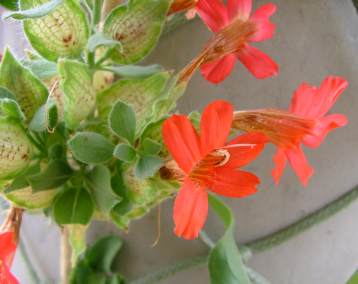Petalidium coccineum
Petalidium coccineum S.Moore
Family: Acanthaceae
Common names: Kaoko petalidium (Eng.); rooi-tongklapper, Kaoko rooibekkiebos (Afr.)
Introduction
The Kaoko petalidium is a fast-growing, branched shrub with smooth, white bark which contrasts with its striking, red, curved flowers and ornamental, mottled bracteoles. The flowers are borne on short spikes for the greater part of the year.

Description
Description
This is an erect, fast-growing, moderately branched, slightly aromatic shrub, reaching up to 2.5 m tall with a tendency to scramble. It becomes woody with age and has striking, white, smooth bark. It has fibrous roots. Branches are first square and green, becoming rounded and up to 30 mm in diameter at the base; the younger branches have glandular hairs. The light green, egg-shaped leaves (heart-shaped at the base) are spreading and are arranged in opposite pairs. The petioles are 10-24 mm. The leaf blade is 40-65 X 30-40 mm, the margin is shallowly saw-toothed with a prominent midrib and parallel veins; the surface is sparsely glandular-hairy, becoming hairless and shiny; the tip is acute.
The flowers occur in short racemes up to 40 mm long, borne in the leaf axils. Each raceme consists of 3-8 flowers. Bracts are leaf-like and ovate-lanceolate, about 15 X 8 mm and deciduous. The base of each flower is covered by a pair of firm, purplish, mottled, protective bracteoles, 25 X 16 mm. The glandular-hairy (sticky) bracteoles are egg-shaped, concave and enclose the young flower. The bracteoles soon become dry and grey, but persist on the branches. The flowers (corolla) consist of a 30 mm long, yellowish green, curved tube, 5-lobed at the end and 25 mm in diameter; the lobes are red, oblong and spreading, the stamens are fused to the throat, but free for about 10 mm and the anthers are about 5 mm long, are positioned at the mouth of the flower or protrude slightly. The smooth seed capsules are about 12 mm long.
Distribution and habitat
Distribution description
The Kaoko petalidium is restricted to northwestern Namibia and occurs in dry savannah in the Kaokoveld and Owamboland. The plant featured here was grown from cuttings collected near Kaoko-Oktavi, growing on dolomite outcrops in Mopane veld in frost-free areas. It grows both in full sun and in the light shade of trees. Rainfall is mainly during summer and ranges from 200-500 mm per annum, some years with very little rain at all. Temperatures are high and often exceed 30°C during summer months, with cool nights during winter.
Derivation of name and historical aspects
History
The genus Petalidium is derived from the Greek petalon meaning' leaf' or 'petal'. Coccineum refers to the red flowers.
The genus Petalidium with about 30 species recorded for South Africa and Namibia (35 in the genus) are commonly found in the summer rainfall regions in the bushveld (savannah). The genus is diverse, ranging from small, scrambling herbs to large, robust shrubs. Acanthaceae is a large horticulturally important family, consisting of about 250 genera and 2 500 species. It is very well represented in South Africa (50 genera). Other noteworthy horticulturally important genera of the Acanthaceae in South Africa include Anisotes, Barleria, Blepharis, Crossandra, Duvernoia, Hypoestes, Mackaya, Ruellia, Ruspolia, Ruttya and Thunbergia. Species range from small herbaceous plants to trees up to 10 m tall.
A characteristic of Petalidium and related genera is the hygroscopic fruit capsule which, when moist, releases two flat seeds explosively, hence its Afrikaans name rooi-tongklapper. Children have the habit of placing the capsule under their tongue, which then explodes like a cracker (klapper).
Ecology
Ecology
Its conspicuous red tubular flowers are pollinated by sunbirds. In the wild, flowering is mostly after rain. The seeds, protected in their firm capsules, are explosively released only during rain, scattering the seed in all directions. Associated plants in its habitat include the baobab, Adansonia digitata, Tylosema esculentum, Cyphostemma currorrii, Sesamothamnus benguellensis, Sterculia africana and Pelargonium otaviense. The plants are heavily grazed by herbivores in the wild but resprout rapidly. The soil is a sandy loam and well drained.
Growing Petalidium coccineum
Grow
Petalidum coccineum is a sight to see with its showy, red, curved flowers and contrasting white stems, and is a colourful introduction to horticulture. It is best grown in dry, subtropical, frost-free gardens. It is very drought tolerant and its aromatic, leathery leaves resist insect predation. It is easily grown from semi-hardwood cuttings during the warmer months of the year. It is a rapidly growing pioneer plant and will flower the first season after planting. It also thrives in containers on verandas, and in colder climates can be kept as a house or greenhouse plant.
As a garden shrub, the old, short, flowering branches tend to become untidy and should be pruned during the winter months. The young branches are soft and pliable, but soon become woody. In the Botanical Society Conservatory at Kirstenbosch, the plant is extensively used as a climber on the netted pillars in the house. This has proved a great success and plants flower throughout the year with a peak in summer.
References
- Obermeyer, A.A. 1936. The South African species of Petalidium. Annals of the Transvaal Museum 18: 151-162.Author Ernst van Jaarsveld Kirstenbosch NBG January 2004
Credits
Ernst van Jaarsveld
Kirstenbosch National Botanical Garden
January 2004
Plant Attributes:
Plant Type: Scrambler, Shrub
SA Distribution:
Soil type: Sandy
Flowering season: Sporadic/All year
PH: Acid, Neutral
Flower colour: Red
Aspect: Full Sun
Gardening skill: Average
Special Features:
Horticultural zones









Rate this article
Article well written and informative
Rate this plant
Is this an interesting plant?
Login to add your Comment
Back to topNot registered yet? Click here to register.